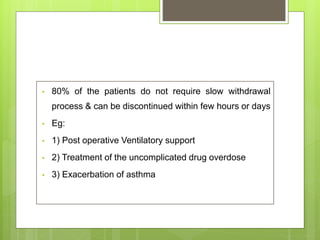Weaning slideshare
- 1. DEPARTMENTOF CARDIOVASCULAR AND RESPIRATORY SCIENCES
- 2. Weaning of the Patient from Mechanical Ventilation Dr. SHIRIL NAGARKAR Professor & HOD DEPARTMENT OF CARDIOVASCULAR AND RESPIRATORY SCIENCES
- 3. Purpose Statement At the end of the class the students should be able to know all criteria's to wean a patient from Ventilator
- 4. Learning Objectives Sr. no Learning objectives domain level criteria condition 1 Define Weaning Cognitive Must know All 2 Explain Weaning Criteria Cognitive & Psychomotor Must know all 3 Explain Different Conditions to wean Cognitive & Psychomotor Must know all 4 Explain role of Physiotherapist in Weaning Cognitive & Psychomotor Desired to know All
- 5. Definition of Weaning The transition process from total ventilatory support to spontaneous breathing. This period may take many forms ranging from abrupt withdrawal to gradual withdrawal from ventilatory support.
- 6. • Once the problem or the condition caused the need for Mechanical Ventilation is resolved, most patients can be quickly & easily removed from the ventilator
- 7. • 80% of the patients do not require slow withdrawal process & can be discontinued within few hours or days • Eg: • 1) Post operative Ventilatory support • 2) Treatment of the uncomplicated drug overdose • 3) Exacerbation of asthma
- 8. Timing • Carefully timed • Premature : stress the cardiopulmonary system & delays the patients recovery • Reintubation
- 9. • Delay : causes, increased risk of complications – Nosocomial pneumonia – Myocardial infarction – Weakness or wasting of inspiratory muscles – Death
- 10. Methods of Weaning 1. Increasing periods of spontaneous breathing (often with T-tube) altering with mechanical ventilation. 2. S.I.M.V 3. Pressure Support 4. Single daily spontaneous breathing trail (SBT)
- 11. Patient Evaluation 1. Important factor to consider in this assessment is the length of time the patient has been receiving mechanical ventilation • < 72 hrs : can be removed quickly • Longer period : needs structural approach
- 12. Condition is improving or not i.e the condition which has lead to the Mechanical Ventilation has reversed or not
- 13. Oxygenation criteria • Pao2 without PEEP > 60 mmHg at 40% Fio2 • Pao2 with PEEP > 100 mmHg at 40% Fio2 • Sao2 > 90% at 40% Fio2 • Pao2/Fio2 > 200 mmHg • PH of 7.25 or greater
- 14. Hemodynamic status • Patient should be hemodynamically stable • Absence of acute myocardial ischemia • Marked hypotension, patient should have adequate blood pressure without vasopressor therapy or only on a low dose (<5 mg / kg of dobutamine )
- 15. Inspiratory Effort • Patient should be able to take a spontaneous breath if the Mechanical Ventilation is discontinued.
- 16. Ventilatory Criteria • Increased thoracic cage movement during spontaneous breathing • Asynchronous chest wall to diaphragm movement • Tachypnea ( > 30/min )
- 17. • Rapid shallow breathing • Use of accessory muscles • Inability to alter ventilatory pattern on command
- 18. • Patient with non of these signs have 90% chance of success • Patient with one or two of these signs usually need continued support
- 19. WEANING PROCEDURE • T- tube trials • SIMV • Pressure support • S.B.T
- 20. • Traditionally, physicians have approached the discontinuation of MV through a gradual reduction in ventilatory support, which is reflected in universally applied but varying forms of “weaning.” • However, this gradual approach may unnecessarily delay the extubation of patients who have recovered from respiratory failure.
- 21. Spontaneous Breathing Trail • Shortly after patients demonstrate that their condition has been stabilized on the ventilator, a spontaneous breathing trial (SBT) is safe to perform and is indicated.
- 22. • SBTs can be performed safely by non-physician HCPs using a T-piece, continuous positive airway pressure without pressure support, or with pressure support up to 7 cm H2O, and for durations of 30 min to 2 h.
- 23. • The monitored assessment of spontaneous breathing should be conducted at least once daily (with the head of the bed elevated and after notifying the patient of the start of the SBT) and should be integrated with other major events in the patient’s daily care, including the cessation or temporary reduction in delivery of sedation and analgesia medications.
- 24. When SBT Is Failed ? All remediable factors should be addressed to enhance the prospects of successful liberation from MV (eg, electrolyte derangements, bronchospasm, malnutrition, patient positioning, or excess secretions) The patient should be placed in an upright position on a comfortable, safe, and well-monitored mode of MV (such as pressure support ventilation).
- 25. • An SBT should be performed at least once daily. • In the face of repeated failures at daily SBTs, clinicians should consider longer-term options, including both tracheotomy and a long-term acute-care or stepdown ventilator facility.
- 26. • Patients have passed an SBT, clinicians seriously consider prompt extubation.
- 27. Summary Definition of Weaning Different Criteria's of Weaning Hemodynamic Status
- 28. Questions Definition of Weaning Discuss the different Criteria's of Weaning Explain Hemodynamic Status with reference to Weaning
- 29. Bibliography David Chang: Textbook on Mechanical Ventilation
- 30. Thank you





























